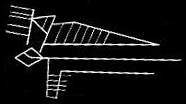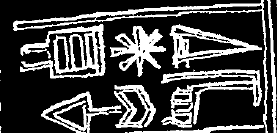Significance of the Kings of Kish
In the Sumerian Kinglsist overview and introdution section, we have
seen scholars (generally) conclude that the SKL in its "original"
form, began with the post-diluvian section, and with the Kish I dynasty
- this is the point in which the 2nd millennium scribes choose to begin
their unique historgraphy. We might ask why Kish? A Semitic city-state
well north of Sumer proper: What is its significance?
After the flood had swept over, and the kingship
had descended from heaven, the kingship was in Kish...
A possible answer may come in consdering the issue of the the flood, a semi-historical occurrence which in the field of ANE studies is understood to be a localized event in Mesopotamia. Backing this up in particular, is the archaeological evidence; layers of clay deposits in Ancient Shuruppak, the city of the traditional flood hero of the same name (or variously, he is named Ubar-tutu, Ziusudra, Atrahasis, or Uta-napistum.) This serves as a possible geological explanation for the course of Early Kingship, for the southern localities were weakened by the flood.. because Kish was so far North the impact of a flood localised in the south would have been much less - it is conceivable than, why at this point the northern Kish should take firm hold of kingship and launch the post-diluvian dynastic period. One scholar whose commentary I found revealing in this, is W.W.Hallo (1)
Hallo: "There is, moreover, some evidence that at the very beginning of dynastic times, lower Mesopotamia did enjoy a measure of unity under the hegemony of Kish. The King List itself records a long list of rulers at Kish before the first rival claimants appeared at any other city. The epic tradition of the succeeding period looks back on a "golden age" when the four quarters of the world lived in harmony and, even, it seems, spoke a common language. As in the Biblical tale of the "Confusion of Tongues," this stage seems to be pictured as the immediate sequel to the Deluge. Classical Sumerian mythology, which describes the gods as untied in an assembly under the leadership of an elective executive, has been interpreted as reflecting an earthly form of "primitive democracy" in the earliest dynastic period, based on a loose league of equals, and it was a king of Kish [Enmebaragesi] who inaugurated the national shrine at the league's religious capital, Nippur. Archaeological evidence too suggests that Kish had the first, if not indeed the only, clear instance of a royal palace in the Early Dynastic Period. Finally, the evidence of the royal inscriptions of all subsequent periods may be invoked to show the high esteem in which the title king of Kish was always held; long after Kish had ceased to be the seat of kingship, the title was employed to express hegemony over Sumer and Akkad and ultimately came to signify or symbolize imperial, even universal, dominion."

King of Kish
Enmebaragesi: The 20th king of the Kish I dynasty establishes national hegemony
So we see that the Kishites were in a unique position to exploit lower Mesopotamia which had been weakened by the flood and that their domination went uncontested for generations: their rule was to become legendary. However, it is not just this period of (unusual) uncontested domenience which makes this dynasty distinct, it was perhaps more than anything the actions of the 20th king of Kish - Enmebaragesi - that would shape Mesopotamia ever after. This king's selection of Nippur as his new relgious and political centre, a city that stood almost exactly in the middle between the Semitic north and the Sumerian south, would lead to a hegemonic authority under the thestic authority of Enlil (forever changeing the face of Mesopotamian religion/politics.) An explantion from F.A.M Wiggerman is insghtful here (2):
"The northern part of lower Mesopotamia had a different name (Wari, later Akkad); a different demographic structure (smaller population centers more evenly spread); and apparently a different tradition of rulership, that of an inheritable kingship. The origins of northern kingship surfaced in later traditions as the (non-Sumerian) legend of the shepherd Etana and his son Balikh, the first king.
Halfway through the third millennium a northern king, Enmebaragesi (Mebaragesi), transformed Enlil's temple in Nippur, exactly between Wair and Kiengir (Sumer), into a national cult center, the first step toward the unification of the two cultural provinces under one king deriving his power from Enlil and the national assembly of gods. With Enmebaragesi and his son Aka, national history began; they were the first kings of the Sumerian Kinglist who were not legendary and whose inscriptions actually have been found. Under the aegis of the national kings, Nippur became in the course of the third millennium the center of a literary culture whose products formed the core of the "Scriptures" of the Babylonian stage of Mesopotamian theology."
The Tummal: the Nippurian political phenomena as an extension of Kishite power/influence:
In "Toward the Image of Tammuz" , p.140, Jacobsen further details that the elaborate political mythology, such as the election of the king of all Sumer with in an assembly headed by An and Enlil at Nippur, may testify to the role of Nippur as gathering point to which "the citizens of Sumerian cities assembled to elect common leaders, "lords" or "kings" as the case might be." He suggests this may be the original political reality behind the myths and later political mythology, which would agree well with the observation "the only term we have for Sumer as a political unit, [is] the term kengir; for there is good evidence that this term was originally a term for Nippur itself, and its understandable that a political organization created in Nippur meetings should take its name from the meeting place." Jacobsen refers collectiviely to the cities brought under the influence of Nippur as the "kengir league."
A document which helps greatly in defining the way in which this league spread, is the Tummal inscription - a record of the building and building of the temple of Enlil by important kings who continued the tradition of the national cult at Nippur. It is in effect a record of the rise and perpeuation of hegemony, and we see that after Kish was defeated by Ur, and by Uruk, the national cult was keep alive and authoritative by the likes of Mesannepadda, Gilgamesh, Ur-Nammu and Shulgi.
Refer here to ETCSL T.2.1.3 (The Tummal inscription)
"These three city states - Kish, Uruk, and Ur - were preeminent
in Mesopotamia throughout this period, as attested not only by the King
List but also by the Tummal Inscription, a brief historiographic essay
on the sanctuaries of Nippur. it credits Enmebaragesi with first building
the temple of Enlil at Nippur. There is no reason to doubt that this
indeed took place in ED II times .Although the city of Nippur had a
long prior existence, and its Inanna temple can be traced back almost
to the beginning of Uruk time (about 3400), there is no prior evidence
of an Enlil sanctuary. Its foundations may well mark or symbolize the
shift from Kish as a political capital to Nippur as religious center
of the rival city-states. If so, it is significant that this foundation
is attributed to a king of Kish, for Enmebaragesi is know as King of
Kish not only from the King List but also from two contemporary inscriptions,
one found as far away as Tutub (modern Khafahe) in the Diyala region.
The Tummal Inscription goes on to credit Enmebaragesi's son Aka with
the construction of the Tummal-building at Nippur. It is less clear
about the rest of Nippur's benefactors. Some sources name next a king
of Ur, Mesannepadda (or Nane), and his "son" Meskiagnunna,
followed by Gilgamesh of Uruk and his son Ur-lugal (or Ur-nungal). Others
reverse this order. Their very uncertainty about, or indifference to,
the precise order seems to indicate that both groups of rulers were
contemporaneous. But Gilgamesh was also contemporaneous with Enmebaragesi,
according to a late royal hymn, and with Aka of Kish, according to Gilgamesh
and Aka, and epic that tells in detail of an unsuccessful siege of Uruk
by an army of Kish. Thus we can synchronize the end of the first dynasty
of Kish,the middle of the dynasty of Uruk, and the beginning of the
first dynasty of Ur."
It is therefore possibly to state that the first Dynasy of Kish is significant not only as the dynasty that occurs first in the "original" state of the Sumerian king list, and not only is it significant as the first dynasty after the flood; but it is significant as the dynasty that established Mesopotamian kingship in character and practice throughout Mesopotamian history.

"The seal of Mes-an-ni-pa-da, who ended the dynasty of Kish. Note the king adopts the title "King of Kish"
move your mouse over the graphic below
 |
 |
Pictures are taken from
"UR EXCAVATIONS
VOLUME III
ARCHAIC
SEAL-IMPRESSIONS
By
DR. L. LEGRAIN"
1. "The Ancient near East: A History
2. CANE III "Theologies, Priests, and Worship
in Ancient Mesopotamia" F.A.M Wiggermann (1996)